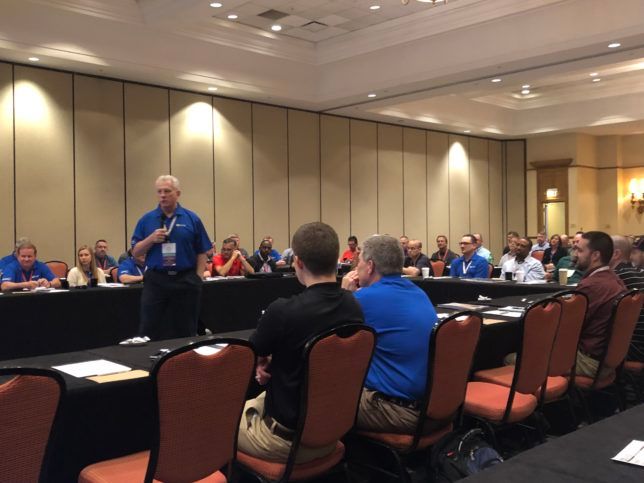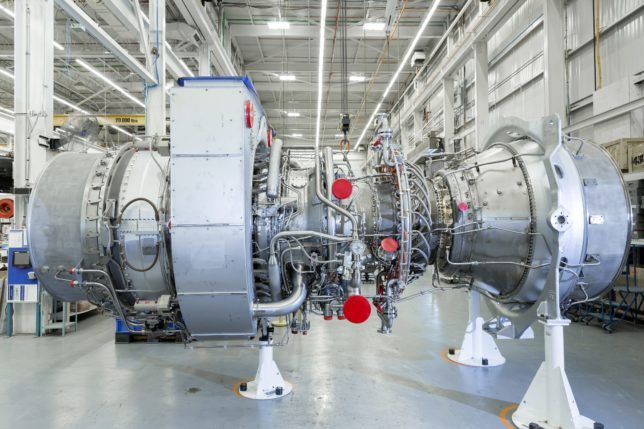IMPROVING O&M IN TURBOMACHINERY
CTOTF USER GROUP BRINGS OPERATORS AND OEMS TOGETHER
By Drew Robb

Caption: Chairman Jack Borsch addressing CTOTF users
The spring Combustion Turbine Operations Technical Forum (CTOTF) user group meeting in St. Augustine, Florida attracted over 100 users. They wanted to hear from their peers about operations & maintenance (O&M) issues impacting their equipment.
But they also got to hear from Mitsubishi Hitachi Power Systems, GE, Siemens and PW Power Systems (PWPS) about the latest upgrades, developments and fixes for just about every possible type of gas turbine (GT).
Going back a decade or so, an us-and-them mentality was sometimes apparent between users and OEMs. Conferences, such as CTOTF break down those barriers. It was encouraging to see the OEMs actively participating in these sessions.
Not only were they promoting their latest and greatest turbomachinery, there were many examples of OEM representatives openly discussing thorny issues, such as lack of availability of spare parts, faulty components and poor turbine performance.
CTOTF Chairman Jack Borsch welcomed everyone to the 44th year of the user group. Its mission is to be the premier mechanism for the exchange of information to shape, lead and advise the power generation industry. As such, it offered tracks covering topics such as O&M, combined cycle, best practices, leadership, plant safety, environmental systems, as well as those dedicated to specific types of turbomachinery.
Siemens aeros
John-Erik Nelson, Principal Technical Engineer at Braintree Electric led the Siemens aeroderivative (formerly Rolls-Royce) roundtable, focusing on the Rolls-Royce Trent 60 (Siemens SGT-A65). This session was populated by the bulk of existing U.S. users.
Nelson’s utility, for example, bought two Trent 60s that went commercial in 2009, each producing 58 MW (later models can produce as much as 66 MW, with future models planned to reach as high as 78 MW). Another three owners attended, representing more than half the fleet of 27 Trent 60 engines, including a user from an Oklahoma utility that owned seven machines.
Nelson launched a discussion of top fleet issues from the user perspective as well as outage management best practices. He brought up a recent Service Bulletin from Siemens that included a product safety warning about hazardous material found on combustor parts known as hexavalent chromium (hex chrome).
“We are finding hex chrome on most Trents,” said Nelson.
Users traded tips about how to eliminate the problem and how to dispose of hex chrome properly. The session then turned its attention to the lack of availability of parts. Some users found the parts they needed from Turbine Tech while others used APM due to lengthy parts supply delays.
The acquisition of the former Rolls-Royce line of aeroderivatives by Siemens included a clause for Rolls-Royce to continue to provide spare parts, but that transition period is coming to an end.
The efforts of Siemens to take over have been hampered by various factors. A change to the Siemens Enterprise Resource Planning software led to unanticipated slowdowns. At the same time, the closure of its Mount Vernon, OH plant and a warehouse change in the UK caused a disruption to parts delivery. Siemens is bringing on new supply chain partners.
“We are in the midst of exiting from Rolls-Royce since the acquisition by Siemens,” said Angelo Gazzillo, Head of Customer Demand at Siemens in U.K.
This is no easy task. Siemens has now sourced and validated the majority of the existing Rolls-Royce manufactured parts. But some components such as turbine blades remain a challenge. This is due to the complex nature of these parts, the validation process and expertise in suppliers takes time.
“We have introduced more participation with engineering and after sales to improve delivery,” said Gazzillo. “We are also digitalizing our supply chain processes to improve efficiency to all levels of the supply chain.”

Caption: Siemens SGT-A65 gas turbine (formerly Rolls-Royce Trent 60)
HA fleet status
In another session, Steve McHugh, 7HA Product Line Manager of GE Power covered the status of the GE’s 7HA and its HA fleet. To date, there are 89 HA units sold, and 54 more under technical selection. While these units have been ordered all over the world, the U.S. holds the most with 33. McHugh said the fleet now has 300,000 operating hours.
The latest version is the 7HA.02, which can provide 382 MW and 42.3% simple cycle efficiency. It takes only ten minutes to achieve full power, with total combined cycle start times of 23 minutes.
The turbine can be turned down to less than 30% of load and maintain emissions compliance. It can also operate in single-shaft and multi-shift configurations.
Among the improvements to the latest HA version are new titanium R1 compressor blades, a 14-stage compressor, a DLN 2.6+ combustor, a two-piece turbine shell, squealer tips on airfoils to reduce tip stress and the elimination of shims in the compressor.
All hydraulics have been replaced by electronic systems, including inlet guide vanes (IGV) and variable stator vanes (VSV).
“It is now possible to carry out a rotor blade changeout in the field,” said McHugh. “The new 7HA can achieve lower NOx at higher temperatures and has an improved turndown capability.”
Lessons Learned
The turbine has undergone successful full-speed, full-load testing in Greenville, SC and is monitored through GE’s fleet leader inspections. Lessons learned led to several changes.
Number 2 bearing alignment was improved. The VSV torque shaft and IGV actuator mount were also upgraded, as well as a new combustor seal design, more effective cooling holes added to the Stage 1 Nozzles and a heavier damper pin was added to the Stage 1 buckets.
“We noticed an oxidation issue with a single blade component and are proactively replacing them across the fleet,” said McHugh.
The 7HA now has combined cycle efficiency of 62% to 63%. McHugh said 9HA.02 upgrades are aimed at taking efficiency close to 64% via micro channel cooling, advanced sealing, new thermal barrier coatings, ceramic matrix composites, and additive manufacturing parts.
“3D printing has opened the door to parts with cooling microchannels that could never be cast or forged before,” said McHugh. “3D printing has helped to reduce costs, speed development and produce more sophisticated parts that are more durable and lighter.”
Advanced frame roundtable
Olaf Barth, Engineer for Combustion Turbine Operations at Dominion Generation, led the advanced frame roundtable. He introduced Francisco Dovali-Solis, Service Frame Owner H-class for Siemens Gas and Power, for a presentation on the Siemens SGT-8000H Class gas turbines.
With a fleet of over 70 GTs in commercial operation, it has accumulated over one million operating hours since the first unit entered service in 2011. Some 70 units are currently in operation (12 being dual fuel) and another 20 under contract.
The 50 Hz and 60 Hz models use the same combustion system but there are more cans on the 50 Hz version. The rotor can be easily de-stacked on site due to it having a segmented disc assembly with Hirth serration and a central tie rod. Variable IGVs and three stages of variable pitch guide vanes on the compressor provide improved part load efficient.
“All rotating compressor blades can be replaced without de-stacking,” said Dovali-Solis. “The turbine has active clearance control with hydraulic clearance optimization for reduced degradation and clearance losses.”
The SGT-8000H class has a can annular combustor. It has a high-cycling capability due to a fully internally air-cooled turbine section. Overall, it has been designed to have fewer scheduled outages.
All turbine vanes and blades can be replaced without rotor lift. Stage 1 (vane, ring segment and blade) and blade 4 can be replaced without cover lift. To date, 61% combined cycle efficiency has been demonstrated on multiple units.
For example, on the 60 Hz SGT6-8000H startup can be done at up to 30 MW/minute. All units can provide frequency response and grid support.
The package sits high in the center line and has service lifting devices to facilitate maintenance of heavy components. The original 60 Hz version could generate 274 MW. Now, it can produce up to 310 MW. The latest 50Hz SGT5-8000H unit is capable of 450 MW (at ISO conditions).
“Performance increases were attained through small increases in the turbine inlet temperature, compressor mass flow, and combustion cooling air optimization,” said Dovali-Solis.
The 60 Hz fleet has recorded 94.3% availability and 99.8% reliability. Configurations vary from 3 × 1 to 2 × 1 and single shaft, depending on customer and utility preference.
M501J fleet
Barth said that Dominion Generation has several M501J units from Mitsubishi Hitachi Power Systems (MHPS) and all are doing fine. He introduced Yoshifumi Tsuji, Senior Manager of GT Engineering at MHPS to discuss overall fleet status.
There are 29 MHPS J-class turbines in operation with the JAC being the newest. The F-class achieved a TIT of F 1,400°C, the G-class reached 1,500°C, the J-class 1600°C and the JAC is targeting 1,700°C.
“Long-term operation is required to understand component behavior, TBCs and oxidation to achieve durability,” said Tsuji. “Simulations won’t find situations such as spallation of the TBC on a blade or oxidation of hot spots; field experience is required.”
In the J-class, Tsuji said long-term operation at the T-Point facility in Japan led to a design change that eliminated a film hole at one spot to change convective cooling at that point.
Since its introduction in 2011, the MHPS J-class has almost 800,000 hours of operation. 57 have been sold, 39 are in service, and 28 have exceed 8,000 hours. Reliability sits at 99.5%.
The J-class is steam cooled, but the newer JAC has an air-cooled combustion system, as well as thicker TBCs and a directionally solidified last blade with larger flow area.
The compressor has a slightly increased inlet flow, a 15-stage design and a 25:1 pressure ratio. This harks back to the stable M501H design that has been around for 20 years.
“High speed balancing of the JAC been done and it is about to ship to a new T-Point plant for testing,” said Tsuji.
He believes 65% efficiency is achievable in the near future. 3D printed parts will play a part in this as well as dual nozzles with an expanded heat insulating layer downstream which improves reliability.
Next spring’s CTOTF will be held in Louisville, Kentucky in late March, 2020. For more information, visit CTOTF.com